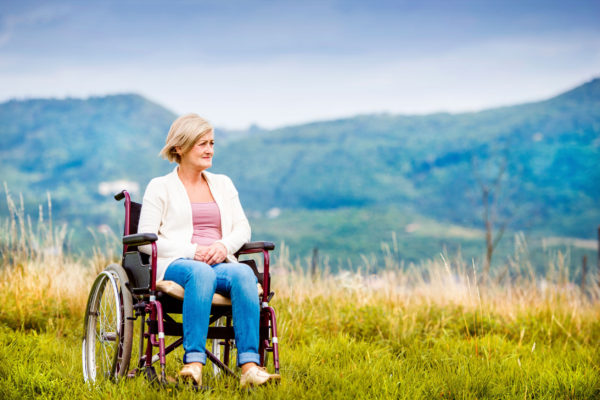On a beautiful late summer day in the Rocky Mountains, I joined participants at the Easter Seals Rocky Mountain Village Post Polio Wellness Retreat to teach a class on balance. People from all over the country came to Colorado to participate in classes and activities about living with post polio syndrome – a condition affecting polio survivors that includes muscle weakness, atrophy, and fatigue that can occur many years after recovery from the original illness.
Post polio syndrome’s impact on balance may result from the effect of muscle weakness on movement control. For one participant, balance problems were her first clue that post polio was beginning to develop. The Minding Your Balance approach to better balance, which explores the impact of awareness on balance control, provides an option when muscle strength is a limited resource.
Awareness as a means to improve physical balance may seem an odd idea, but it’s what gymnasts, skiers, skaters, and martial artists do during balance challenges: they enhance balance control by keeping postural orientation in mind. Where am I in motion in space in relationship to gravity? The same attentional process can make a significant difference in postural stability for individuals dealing with balance challenges not of their own choosing – ones that come from injury, aging, or disease.
Bringing mindful awareness to our sense of balance makes a difference because the physical act of balance depends on the accurate perception of our postural orientation relative to gravity. Without that information the nervous system cannot effectively orchestrate the whole-body muscle activity needed to maintain stability as we move. Dizziness or vertigo, for example, can render the strongest and most agile of individuals unstable on his or her feet because it undermines the perceptual side of balance control.
Beyond Balance – Navigating Space
The perception of our orientation in space relative to gravity serves more than just balance – it provides a perceptual and decision-making framework for movement control in general, including our ability to navigate the world around us.
Accurately perceiving postural orientation in space requires the weaving together of a variety of sensory inputs via the brain. Along with motion sensation from the inner ear, the composite perception includes joint and muscle sensation as well as vision. Vertigo undermines that composite by messing with motion sensation: we feel as if we’re in motion even though we aren’t – and that confuses balance control as well our perception of and relationship to the space around us.
The critical role of postural orientation came vividly to mind in a fascinating conversation I had with a retreat participant named Ann who shared her recent experience with a bout of vertigo. Staying balanced wasn’t an issue because she uses a wheelchair. Still, her distorted perception of postural orientation messed with everything she did. Maintaining control of her seated posture was a challenge; accurately reaching for objects on a desk or table in front of her became a problem – she would navigate her hand to the spot she saw the salt shaker and miss the mark; her ability to control her handwriting fell apart; and she was continually weaving off course or running into things as she navigated her wheelchair through familiar environments.
Ann’s experience illuminates the critical nature of accurately perceiving postural orientation in space. Along with being essential to balance, it provides a contextual framework for the decision-making that guides our movement in and interaction with the environment. Interestingly, it’s only when something goes wrong that we even know we have this integrated perception, let alone realize the essential role it plays. Fortunately for Anne, she was able to resolve the dizziness after a few harrowing weeks by doing head tilt exercises for benign positional vertigo.
Recognizing the nature of the perception of postural orientation in space (hopefully without going through the trauma of vertigo) allows us to better take advantage of the foundation it provides. Just as paying attention to what we see or hear improves perception and performance, bringing awareness to our sense of balance and space – to our orientation in the environment relative to gravity – helps us take better control of balance and of our ability to navigate in the world.


2 comments